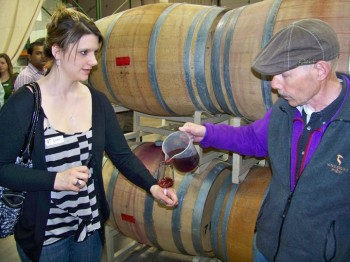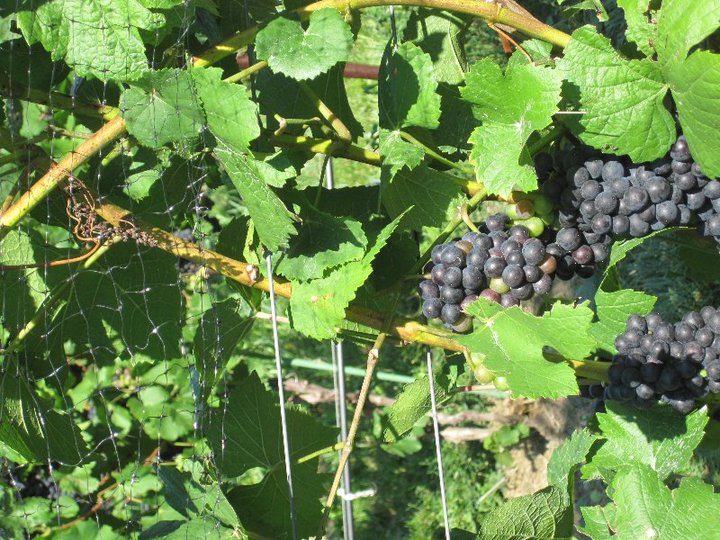
Bob Madill, general manager at Sheldrake Point Vineyards, does not necessarily agree with the way I describe his feelings on pinot, but I’ll stand by it: I think he’s had a change of heart. The question is, why?
Back in 2008, Madill and I had a discussion about pinot and how it grows in the Finger Lakes. I don’t have detailed notes of that conversation, but I can clearly remember Bob’s skepticism about pinot’s future here. He’s a Burgundy lover, and someone who appreciates the subtleties and complexities of pinot noir. Could you really expect to make complex, nuanced pinot, he asked, in a climate that was often so wet during harvest?
After all, wetness brings disease pressure, and pinot noir is one of the thinnest-skinned of grape varieties. It’s extremely susceptible to rot and affliction. Madill was stressing the point that climate data shows the Finger Lakes as one of the wettest wine regions in the world during harvest — on average. To state the obvious, this is variable, but he was looking at climate data that looked at history.
Fast forward to 2013 and Madill is working very hard on his own, small-lot pinot noir. Lenn Thompson reviewed the first vintage of Sheldrake Point’s BLK 3 Pinot Noir earlier this week.

“I’m fussy,” Madill told me, although to anyone who’s met him, he needn’t state the obvious. He is famously fussy and carrying high standards. “I can baby the vines. I can tend to them very specifically,” he continued, and then added a key point: “I don’t need great commercial success with this particular wine. There’s not much of it.”
Madill was not saying that pinot noir can never be financially viable in the Finger Lakes; however, he was indeed saying that it is a fool’s errand for all but the most dedicated growers and winemakers.
“I would think that only a handful of people are doing it right now,” he says. “Six, maybe eight or so. There’s a character and quality of pinot that we’re just barely moving toward in the Finger Lakes.”
When I ask him why he’s had a change of heart, he says, “I don’t know that it’s a change of heart. It’s really about coming to terms that it can be done-it really can-but it requires a great deal of work.”
Fair enough. There is not a single moment when a wine region makes a declaration about which grape or another becomes a standard bearer, but Madill’s conversion must be seen as evidence that such an occurrence is in process. Today there are several wineries producing only pinot noir and riesling (Heart & Hands, Forge, Bellwether), and a small-but-growing group that is focused on pinot in the way that Madill describes. Ravines, Damiani, Red Tail Ridge, and others — this is not a complete list, and it’s fair to say other wineries could merit a spot, but the list is nonetheless rather compact.
Beyond Lenn’s review of the 2009 BLK 3, Madill shared his thoughts on what’s to come. He’s at his most entertaining when he’s blunt, which is most of the time, and he’s blunt about the 2010 vintage. In short, he thinks it’s not nearly as good a red wine vintage as many people were hoping. (And by the way, recent tastings indicate the 2010 Finger Lakes reds are, at minimum, much lighter than other celebrated vintages, including 2007 and 2012.)
“There just wasn’t nearly as much ripening in 2010 as some people seem to say,” Madill says. “It’s a light year. Our pinot is light. That’s okay, because it reflects the vintage.”
He is very high on 2011, a year that brought great challenge but also great potential. And the early returns on 2012 are almost puzzling, because unlike 2010, there was no question about ripening.
“We had water in 2012,” he says. “Just enough, and not too much, and ripening just continued right along. And this pinot is burly! I like pinot that’s charming and aromatic. The 2012 is gutsy. I don’t really know what to make of it. It’s almost perfect, but then it’s almost too much of a good thing. I’m very curious to see where it goes. It’s a structured wine.”
It’s really about coming to terms that it can be done — it really can — but it requires a great of work. You’re better off not doing it at all if you’re not prepared for the challenge.”
So what’s next for pinot in the Finger Lakes? Madill would like to see the number of serious producers grow; he echoes Tom Higgins of Heart & Hands in that regard. And he says winemakers must accept that pinot doesn’t create a buzz as easily as other varieties, particularly in wine competitions. “These wines are easy to take for granted,” he says. “I’ve had these wines in wine competitions and some judges say, ‘It’s wimpy!’ But of course that’s missing the point. Some people don’t know what the fuss is about, but great pinot is subtle.”
And he’d like to see continued cooperation between the Finger Lakes and his home of Ontario, Canada. “There’s more serious pinot in Ontario than there is here, by a longshot,” he says. “At one point the two regions seemed to have more communication, and then it disappeared for a while, but now it seems to be coming back.”
Still, I can’t get Bob to admit he was wrong. He says he’s simply open-minded but stubborn about high standards. Other red varieties have shown success without breaking out; cabernet franc and blaufrankisch come to mind. Pinot is the red grape of the moment, and it’s an open question as to how long that moment will last. Bob Madill won’t have to admit he was wrong if, years from now, his wines do all the talking for him.

